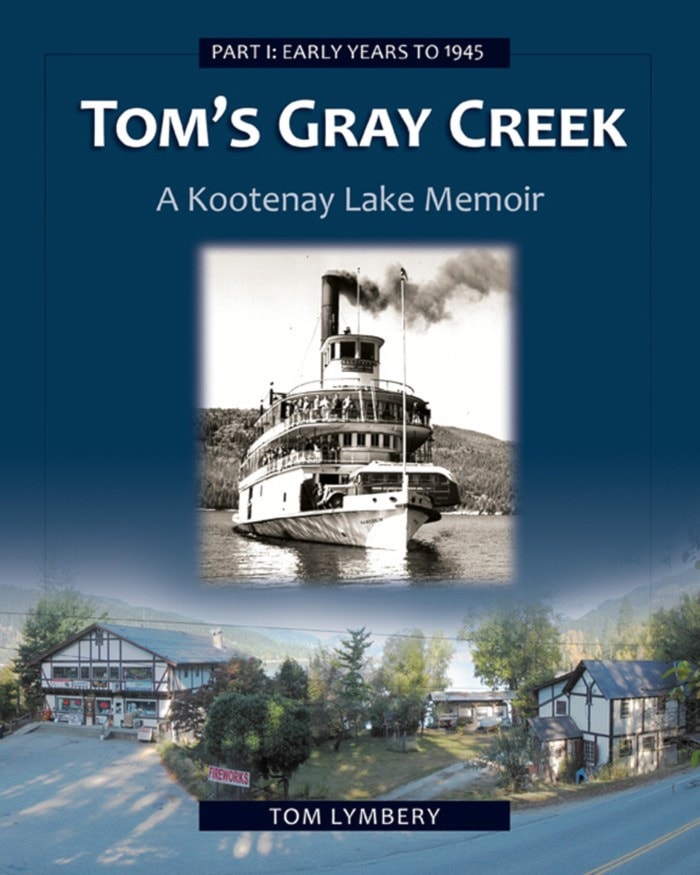Back in the day, “vanity publishing” conjured thoughts of big egos and questionable quality. But as technology has galloped into a new age, self-publishing — or indie-publishing — has come into its own.
While self-publishing your “Great Canadian Novel” may be a relatively new phenomenon, self-publishing local history is almost as old as the hills these invaluable books describe. This “vanity” offers a reflection of ourselves through a window into our collective past.
Our Kootenaiana section of the library is rife with local histories both self-published and published by small local presses.
And they are oh, so important.
The latest of this brave tribe to cross my desk is Tom’s Gray Creek: a Kootenay Lake Memoir (part 1). Tom’s a local treasure — the Lymbery family and the iconic Gray Creek Store (the jewel of Chainsaw Avenue) have been part of that community for more than a century — and so it’s no surprise that the book should be as well.
With 220 pages of drawings, maps, photos, memories, and fascinating sidebars, Tom’s memoir is a truly engaging local history.
Find out why “shook” will keep your apples from rolling away, how the “bug” that lights your way doesn’t need legs, or how to feed your family on 10 cents a meal (and other lessons from the Depression).
Tom’s Gray Creek covers the early years of the community until 1945, and I can’t wait for the next volume.
Other faves in our collection include the indie-published Lost Orchards: Vanishing Fruit Farms of the West Kootenay (see “shook,” above) by Joan Lang; Kenneth Morrow’s books, including A Boyhood in Nelson: Growing up During the Depression, and the (I can only assume) unrelated book Ladies of Easy Virtue in the West Kootenay; Larry Jacobson’s Salmo Stories, and Set in Stone: a History of Trail’s Rock Walls by Eileen Pedersen.
Some names become synonymous with local history, among them Terry Turner, writing about Riondel and environs (Bluebell Memories, More than a Memory, and Impressions of the Past, the latter written with Susan Hulland). Milton Parent’s histories of Nakusp and the logging trade include Bugles on Broadway and Caulkboot Riverdance, and Art Joyce gave us A Perfect Childhood: One Hundred Years of Heritage Homes in Nelson, and Hanging Fire and Heavy Horses: A History of Public Transit in Nelson.
Diaries are an enlightening and entertaining personal window to the past, full of day-to-day detail. Check out the multiple volumes of Dorothy’s Stormy Lake, the journals of Dorothy Brown from the 1930s onwards, and Fishes and Wishes and Fruit, the 1915 diary of H. Colin Haddon (of Gray Creek).
A few more of note: The Geography of Memory: Recovering Stories of a Landscape’s First People introduces the ethnography and history of the Sinixt people, full of maps, drawings, and photographs; Joe Irving’s memoir Red Iron Over the Canyon describes this former ironworker’s experience building bridges you might pass over every day, among other projects; and Moyie author Arlene Pervin entertains with Kootenay Tales.
I would be remiss not to mention small publishers who know that the love is big, even if the returns are sometimes small.
Thanks to Sono Nis Press for publishing The Third Crop, a shoebox photo exploration undertaken by Rita Moir, and to Oolichan Books for Historic Nelson: The Early Years by John Norris, to name just a couple.
As I write my desk is piled high with contenders for this column, not all of which received mention. But the message is as clear as your own reflection: without our local histories, we can’t properly see ourselves. There’s nothing vain in that.
— Anne DeGrace is the adult services coordinator at the Nelson Public Library. Check This Out runs every other week. For more, nelsonlibrary.ca.
